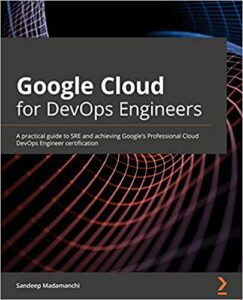Sandeep Madamanchi is the author of Google Cloud for DevOps Engineers, we got the chance to sit down with him and find out more about his experience of writing with Packt.
Q: What is/are your specialist tech area(s)?
Sandeep: I consider Cloud Infrastructure as my area of expertise. My core strength is architecting a challenging problem by working with multiple cloud services. I am a continuous learner, focused on building highly resilient, secure, and self-healing cloud infrastructure. I advocate SRE and its practices to achieve reliability and operational stability. My vision is to provide infrastructure as a service to core engineering, analytics and ML specialized teams through DevOps, DataOps and MLOps practices
Q: How did you become an author for Packt? Tell us about your journey. What was your motivation for writing this book?
Sandeep: I have the habit of writing content in the form of a guide especially when I solve challenging problems. Although this was mostly domain-related and confined to my work at Manhattan Associates, over the last 2 years or so, it helped me write technical blogs on Medium. My intention was to share my knowledge with as many folks as possible in a concise manner. In August 2020, Riyan from Packt reached out to me with a book writing proposal, specifically on the lines of Google’s take on Site Reliability Engineering (SRE) and its practical implementation through Google Cloud Services. Having taken the Professional Cloud DevOps Engineer Certification exam, I saw first-hand how tough the exam was. It was difficult to comprehend SRE concepts without any real-world implementation (especially when SRE is still a new practice outside Google). This presented an opportunity for me to elaborate on these concepts in a way that anyone can understand. By the time of the book proposal, I had written a few decent blogs on Medium that were well received, so, I decided to go ahead with the idea of writing a book.
Q: What kind of research did you do, and how long did you spend researching before beginning the book?
Sandeep: To be honest, one of the reasons I agreed to write the book was that I already spent more than a year studying and comprehending Site Reliability Engineering. In addition, I had hands-on experience with multiple Google Cloud Services along with Kubernetes during my time at Manhattan Associates. So, I knew what approach to take to write content for the book.
Q: Did you face any challenges during the writing process? How did you overcome them?
Sandeep: The biggest challenge was to understand the difference between writing a blog versus a book. Writing a blog is more informal and more or less is targeted at a specific problem. It’s completely okay to assume that the readers have prior knowledge of certain aspects. However, the process of writing a book is more formal, and it is essential to establish the fundamentals as the chapters progress. The content should be structured and should have a nice flow. It took me about 2 weeks to adapt to the book writing style. Rahul from Packt really helped me during the first few weeks. I also did not publish any blogs during this time as I wanted to be in that zone of writing for a book. That mental adjustment went a long way The other challenge was my change in job to Variant (just 2 months after I started writing the book) where I had to work with AWS every day instead of Google Cloud. This was initially challenging, but eventually the most rewarding experience. I had the service names jumbled up in my head for the first two weeks. I was working with AWS services till the evening and then working on the book about Google cloud services for the rest of my time. It helped me to develop a deep understanding of both the cloud platforms.
Q: What’s your take on the technologies discussed in the book? Where do you see these technologies heading in the future?
Sandeep: DevOps as a practice has existed for a while. However, SRE is Google’s take on DevOps aimed at achieving system reliability through the principles of software engineering. SRE is picking up and very soon will be an extremely popular jargon. The upside is that SRE’s principles are not restricted to the Google cloud. These can be implemented on any cloud provider like AWS, Azure, and Oracle. The downside is that very few companies outside Google have successfully established the SRE culture or practice. This is because not all companies are at a maturity level where they can define Service Level Indicators (SLIs) and set Service Level Objectives (SLOs) to achieve Service Level Agreements (SLAs). So, it might take more time than normal for a majority of the companies to successfully implement. Other key technologies that are discussed in this book are DevOps essentials like centralized code management, artifact management, container orchestration via Kubernetes, monitoring, alerting, tracing, debugging, and so on, but focused through respective Google cloud services. These services form the core of Google Cloud strategy and will remain that way for quite some time.
Q. Why should readers choose this book over others already on the market? How would you differentiate your book from its competition?
Sandeep: SRE Elaborated in a compact way → SRE concepts are extremely deep and wide. This book elaborates many concepts such as defining user journey, categorizing user journey, exploring ways to measure SLIs, identifying golden signals for a user-facing system, building SRE teams, defining SRE engagement, exploring cultural practices with focus on collaboration, and much more. This book covers these concepts are approached in a manner that makes it feasible to implement on public cloud providers outside Google as well.
Google’s Professional Cloud DevOps Engineer Certification → The book helps in preparing for the certification exam as it covers key concepts that can be assessed – specifically centered around SRE, GKE and cloud operations. Prior to this book, a well-rounded book that covers the contents of this exam doesn’t exist on the market. The book also includes 200+ questions across chapter-based tests and mock tests.
Q. What are the key takeaways you want readers to come away from the book with?
Sandeep: The book will help readers to gain a solid understanding of SRE’s technical and cultural practices, along with considerable knowledge of Google Kubernetes Engine (GKE) and Google Cloud Operation services that are critical to establish observability for complex distributed systems.
Q. What advice would you give to readers learning tech? Do you have any top tips?
Sandeep: Technology is ever-evolving and pretty much nobody knows where the finish line is. As a result, it is important to keep up with the changing trends. The focus should be on learning beyond what’s required for day-to-day work, with an eye on the future. The best way is to get as much hands-on as possible and this could also be implementing poc’s if not a fully functional and a scalable system.
Q. Can you share any blogs, websites, and forums to help readers gain a holistic view of the tech they are learning?
Sandeep: I am a big fan of blogs written on the Medium platform. Given that my area of interest is Cloud Infrastructure, Data Engineering or DataOps and MLOps, I recommend the following publications on medium → Better Programming (https://betterprogramming.pub) and Towards Data Science (https://towardsdatascience.com). I like to read engineering-specific blogs from Netflix and Google. LinkedIn is also a good platform for lots of great information, though it depends on the individual’s network.
Q. How would you describe your author journey with Packt? Would you recommend Packt to aspiring authors?
Sandeep: I would say my journey was pretty smooth. I had a great team that was flexible and worked around my schedule. I will strongly recommend to aspiring authors specifically to those who are constantly looking to learn and have a strong intent to share.
Q. How did you organize, plan, and prioritize your work and write the book?
Sandeep: My intent was to stick to the timelines agreed between me and the Packt team during the planning phase. As a result, I used to spend at least 4-5 hours after work on weekdays and 6-10 hours on weekends working on the book. The intensity increased as we came closer to the finish line. Essentially, it was a balancing act on a daily basis. It became a little more challenging but also rewarding when I was working with AWS services by the day and Google Cloud services by the night. The mental adjustment took some time, but it was clockwork once I got into the rhythm.
Q. What is that one writing tip that you found most crucial and would like to share with aspiring authors?
Sandeep: It is important to think through the flow and the structure. The thought process should be continuous as the author moves to the next chapter since the content should flow across chapters as well.
Q. Would you like to share your social handles? If so, please share
Sandeep: LinkedIn → https://www.linkedin.com/in/sandeep-madamanchi-51aaa810 Twitter → @cloudsandeep Medium → https://sandeep-manchi.medium.com
You can find Sandeep’s book on Amazon by following this link: Please click here









